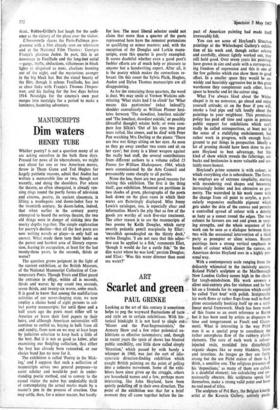Scarlet and green
ART PAUL GRINKE
Looking at the art of this century it sometimes helps to peg the wayward fluctuations of taste and style on to certain exhibitions. With his- „ torical hindsight it is not hard to single out,. `Manet and the Post-Impressionists,' the Armory Show and a few other polemical ex- hibitions as effective tastemakers; and, though in recent years the spate of shows has blunted public sensibility, one little show called simply 'Situation,' which passed by with barely a whimper in 1960, was just the sort of idio- syncratic direction-finding exhibition which caught British painting on the point of gelling into a cohesive movement. Some of the exhi- bitors have since given up the struggle, others are household names and a few, perhaps more interesting, like John Hoyland, have been quietly pedalling off in their own direction. The point of the exhibition was that for a brief moment they all came together before the im-
pact of American painting had made itself irrevocably felt.
You can see some of Hoyland's Situation paintings at the Whitechapel Gallery's exhibi- tion of his work and, though rather solemn and carefully, almost tightly worked out, they still hold good. Over seven years his paintings have grown in size and scale with a correspond- ing freedom of expression and this is one of the few galleries which can show them to good effect. In a smaller space they would be un- wieldy and boorishly aggressive but in this great warehouse they complement each other, have space to breathe and let the colour sing.
What I've always liked about the White. chapel is its no nonsense, go ahead and enjoy yourself attitude; sit on the floor if you will, smoke a foul pipe and talk loudly about the paintings to your neighbour. This permissive policy has paid off time and again in genuine public support for exhibitions which can't really be called retrospectives, at least not in the sense of a stultifying enshrinement, but rather work in progress, with enough back- ground to put things in perspective. Ideally a lot of pruning should have been done to pre- sent Hoyland to best advantage, but this kind of show which reveals the falterings, set- backs and hesitancies is more valuable and cer- tainly more honest.
Hoyland's prime concern is with colour, to which everything else is subordinate. The forms he employs are of extreme simplicity, starting with meandering oval shapes and becoming increasingly bolder and less obtrusive as geo- metry. The watershed in his work came with the change from oil paint to acrylic, a parti- cularly responsive malleable pigment which gets under the skin of the canvas and permits a controlled spread of colour with a density as hazy as a sunset round the edges. The two colours he favours are red and green in vary- ing strengths, and the whole sequence of his work can be seen as a dialogue between those two with the occasional intervention of a third party as prompter or silent witness. Recent paintings have a strong vertical emphasis in bands of colour which dissect the canvas, an American device Hoyland uses in a highly per- sonal way.
With a contemporary scale ranging from the delicately whimsical to the incisively austere, Roland Piches sculpture at the Marlborough New London Gallery comes high in the charts for tough-mindedness. His work answers a silent mid-century plea for violence and he has hit on a formula for its expression which could be called Tart brut' with polish. Sculpturally his work flows or rather flops from wall to floor plane occasionally hooking itself up on a recti- linear metal framework. Much has been made of this frame as an overt reference to Bacon but it has been used by artists as disparate in time and temperament as Fuseli and Giaco- metti. What is interesting is the way Piche uses it as a spatial prop to coordinate the rather amorphous flow of the rubbery plastic elements. The core of each work is colour injected resin, moulded into disturbingly organic shapes like so many bladders, livers and intestines. As images go they are fairly strong but the use Pichd makes of them is, I think, a sensitive one. The religious presence of his 'depositions,' as many of them are called, is a doubtful element; too calculating and un- necessarily obscure. His sculptures speak for themselves, make a strong valid point and have no real need of titles.
The sculpture of Pol Bury, the Belgian kinetic artist at the Kasmin Gallery, actively para. cipates in organic growth. What may at first appear to be a honeycomb of pegs, a group of balls or a mesh of fronds reveals, to a careful scrutiny, an almost imperceptible movement accompanied by a gentle mechanical susurra- tion like the clicking of insects in dead wood. The subtlety of Bury's conception of growth and time is matched by a simplicity of con- struction which never intrudes.



































 Previous page
Previous page